Thatte Idli | Plate Idli
The popular South Indian snack Idli is one of those dishes, which is usually soft and fluffy in its texture. But what if I say that there’s another variant, especially from Karnataka, which is softer, fluffier and lighter? Yes, it’s the Thatte Idli that is incredibly soft and porous like a cloud! Also known regionally as the Plate Idli, it has been a personal favorite too, since quite some time. In this post, I share my recipe, which, after you try, will make you really thank me. Go for it!

About Thatte Idli
‘Thatte’ refers to a ‘plate’ in Kannada language. Hence, Thatte Idli or Plate Idli is a distinct type of idli from the southern state of Karnataka, particularly from regions like Tumkur and Bidadi near Bangalore.
Unlike the traditional, small, and fluffy idlis found across South India, Tatte Idli is larger, flatter, and steamed in shallow plates or round trays instead of the small moulds typically used for regular idlis.
Thatte Idli or Tatte Idli’s origins are attributed to local small-scale eateries that served workers and travelers along the highways.
These roadside stalls needed a quick yet hearty meal that would appeal to everyone, and the larger, plate-shaped idlis fit the bill perfectly.
Plate Idli is believed to have been first introduced by enterprising cooks looking to serve a filling, easily shareable version of the idli that could be served quickly.
Its larger size and unique texture helped it gain popularity among truck drivers and long-distance travelers who frequented highway eateries.
Using the plates would also ensure fewer utensils and quick cleanups for many of these eateries and restaurants.
Today, Thatte Idli is enjoyed not just in Karnataka but across South India, celebrated for its unique taste, size, and satisfying texture, making it a much-loved version of the classic idli.
Why Thatte Idli is super soft?
A very well-known street food as well, the batter of Tatte Idli is different from the batter of the regular Idli.
Along with the usual idli rice and split black gram (urad dal), puffed rice or flattened rice (poha) and sometimes sago (sabudana) are also added, which make these idlis incredibly soft and cloud-like. Having said this, it is also possible to make regular idli with the batter of Plate Idli.
About My Recipe
In my recipe of Thatte Idli, I use both thick poha and sabudana which make these idlis super soft and light. You can substitute the poha with puffed rice, if preferred.
The process is similar to preparing an idli batter – you’ll need to soak, grind the ingredients, and ferment the batter. Afterward, steam it in plates.
I make Tatte idli on special occasions, and this is one of the best recipes you can try. This method is especially handy if you don’t have a Plate Idli stand or steamer.
Just use small-rimmed plates and steam the idlis in a pan or pot. With my detailed instructions below, you’ll be able to make soft, spongy Thatte Idli easily at home.
Tatte Idli or Plate Idli is traditionally served with coconut chutney and a spicy sambar, with a dollop of butter or ghee and a few sprinklings of idli podi, often added for extra flavor.
If you love trying various types of idli, you can also have a look at my recipes of Ragi Idli, Kanchipuram Idli, Oats Idli and Millet Idli.
Step-by-Step Guide
How to make Thatte Idli
Soak Ingredients
1. In a bowl, take ¾ cup (150 grams) split skinless black gram (urad dal) and ¼ teaspoon fenugreek seeds (methi seeds).
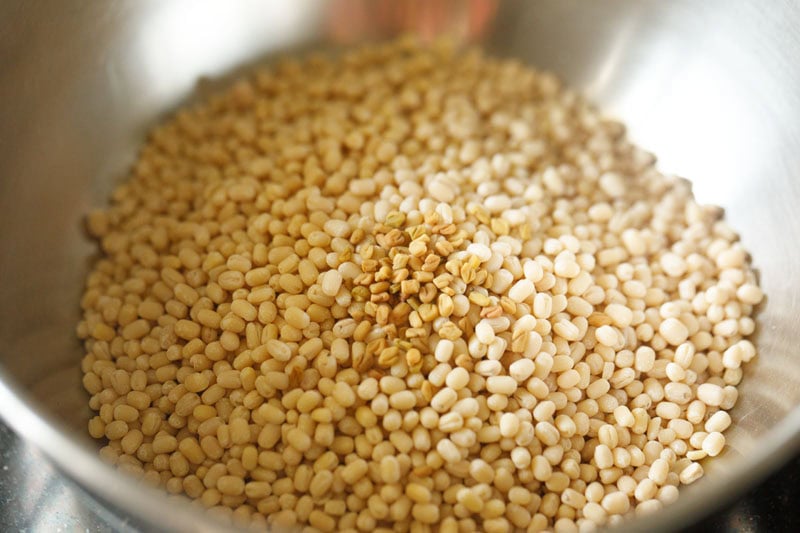
2. Rinse with water a few times. Soak the lentils and fenugreek seeds in 1 cup water for 5 hours.

3. In another bowl, take 2 cups (400 grams) idli rice and ½ cup (40 grams) thick flattened rice (thick poha).
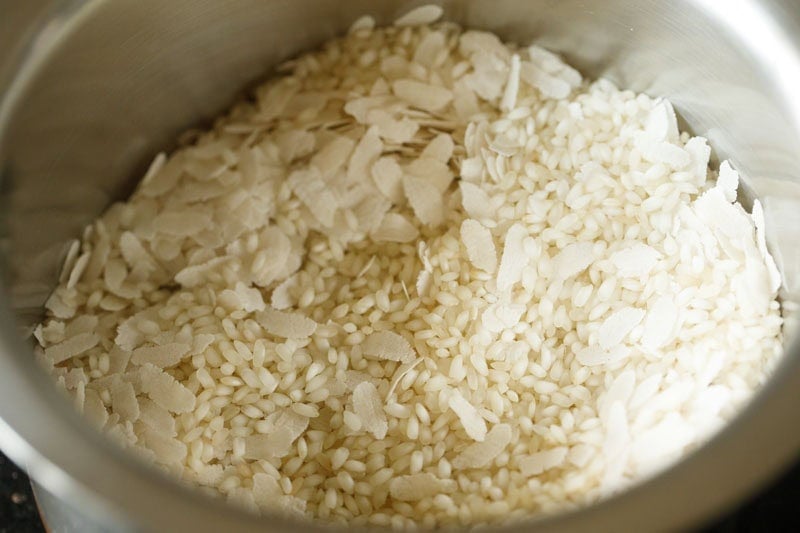
4. Rinse again with water, for a couple of times. Then, soak in 2½ cups water for 5 hours.

5. Similarly, take ¼ cup (40 grams) sago/sabudana in a small bowl.

6. Again, rinse with water and soak in ½ to 1 cup of water for 5 hours.

Make Batter
7. Before grinding these soaked ingredients, drain all the water from them and keep aside.
In a mixer-grinder or a table-top wet grinder, take the lentils, fenugreek seeds and sago together.
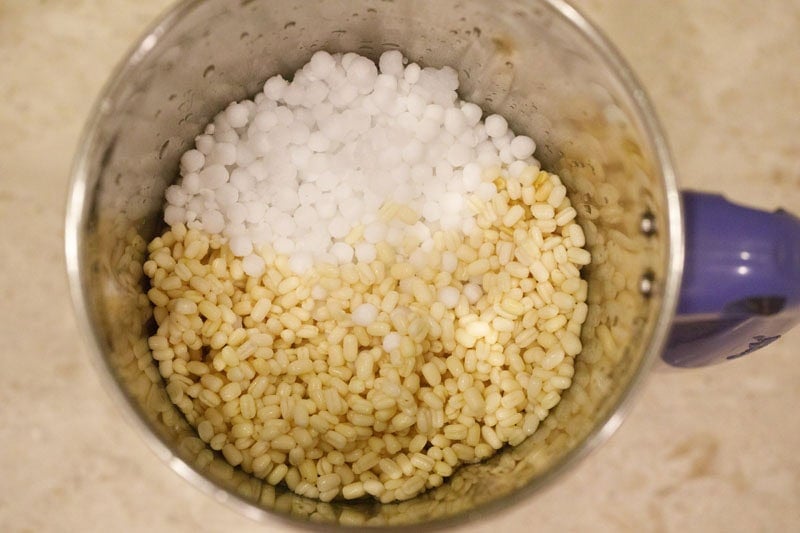
8. Add 1 cup water and grind to a fine consistency. The batter should not have any granular consistency, and should be fine and smooth.
Transfer this batter to a large bowl or pot.

9. In the same grinder, add a portion of soaked idli rice and thick flattened rice. Add some water and grind to a fine, grainy consistency.
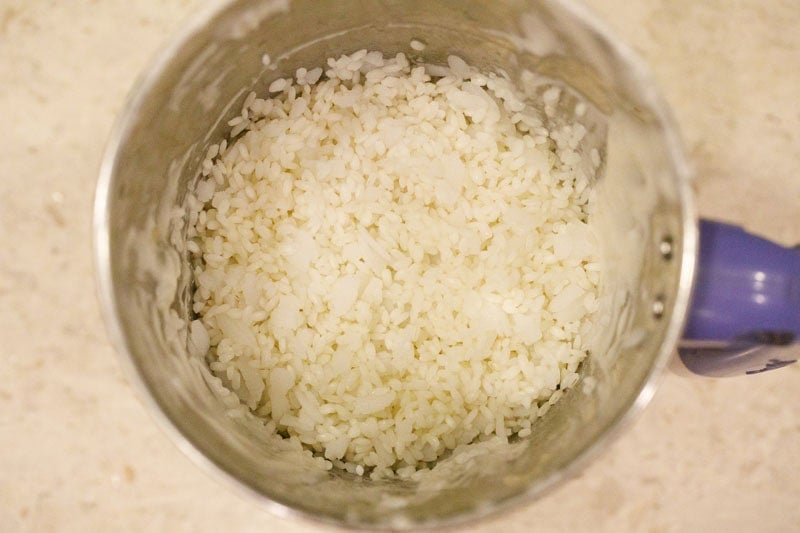
10. Same way, grind the idli rice and thick flattened rice in batches of 1 to 3. You will need to add a total of 1 cup water in portions, while grinding in batches.
Ensure that the rice batter is not very thin or thick.

11. Pour the rice batter into the same bowl containing the lentil batter. Add 1 teaspoon edible rock salt or according to taste.
Remember not to make the thatte idli batter too thick. Opt for a medium-thick and flowing batter.
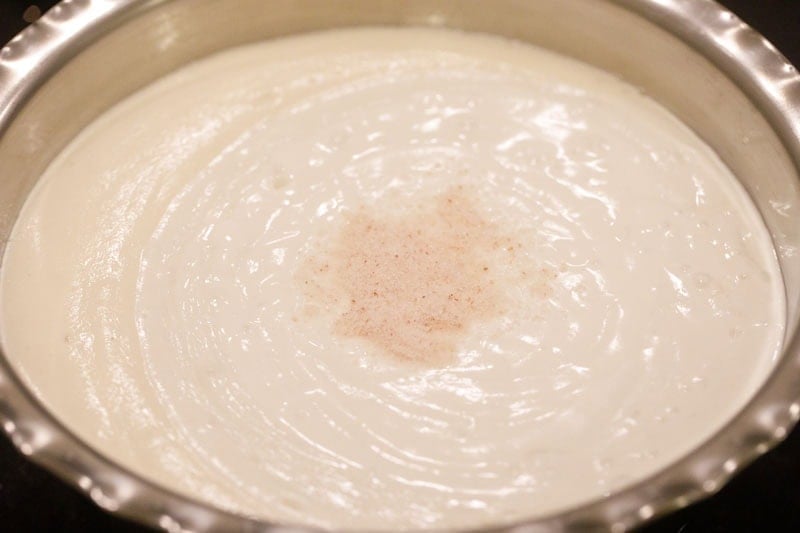
Ferment Batter
12. Mix 1 teaspoon edible rock salt thoroughly with a spoon or spatula. Use pink salt or sea salt in place of rock salt, if you do not have it.
Cover the bowl/pan with a lid and allow the batter to ferment for 8 to 9 hours or until the batter increases in volume and doubles or triples.
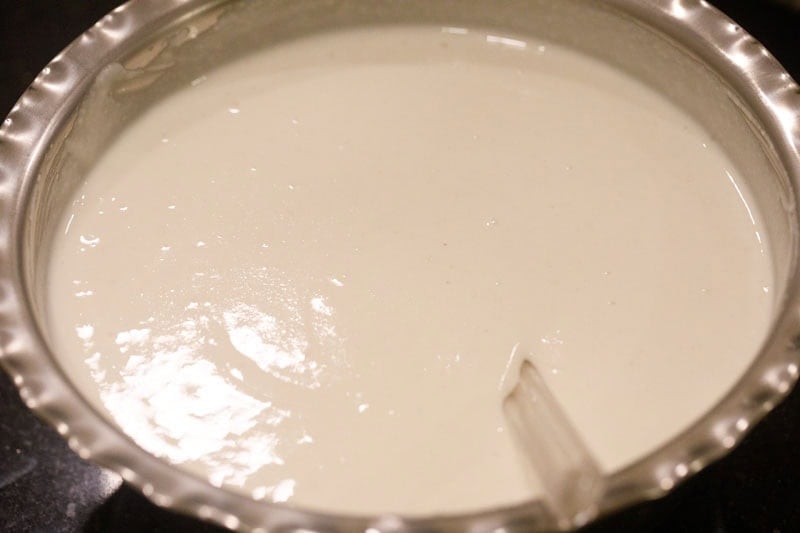
13. The batter will also have a nice fermented aroma and plenty of air-pockets.
Note: If fermented well, no need to add baking soda. If not, then add ¼ to ⅓ teaspoon. I did not add baking soda.

Steam Thatte Idli
14. Grease oil or ghee lightly on small plates measuring 3 to 6 inches or the special idli plates that you get in the market to make this thatte idli variant.
Pour the prepared batter covering ¾ᵗʰ of the plates.

15. Take a large kadai (wok) or a large pan that can accommodate all the 3 or 4 plates. Add 2 to 3 cups water depending on the size of the kadai or pan. Place a trivet. Let the water begin to simmer gently.
You will have to steam these 3 or 4 plates in batches in the pan or pot. If you have the specialized Thatte Idli plates, then use these plates and the stand that comes with these.
You can also use a dhokla stand or shallow bowls. If you used the Thatte Idli plates & stand, then use an idli steamer to steam.

16. Reduce heat and gently and carefully place the plates with the batter on the trivet.

17. Increase the heat to medium or medium-high.
Cover the kadai or pan with a lid and steam for 15 to 20 minutes or until the plate idlis are firm to touch. A toothpick or fork inserted should come out clean.
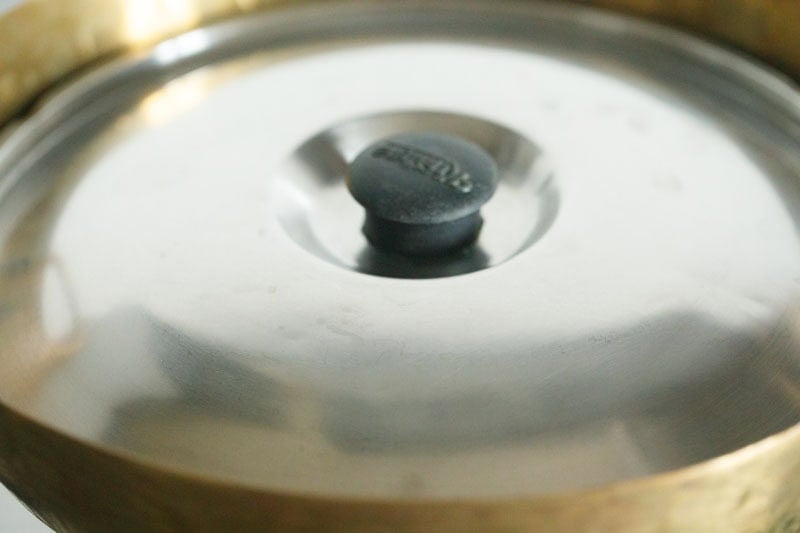
18. Carefully remove the plates with tongs, as they will still be hot. Rest for 5 minutes and then, gently remove plate idli with a water moistened spoon or butter knife.
Place on serving plate and spread some ghee on top. Sprinkle with Idli Podi and spread on the idlis.
Serve Thatte Idli hot with Coconut Chutney and/or Sambar.
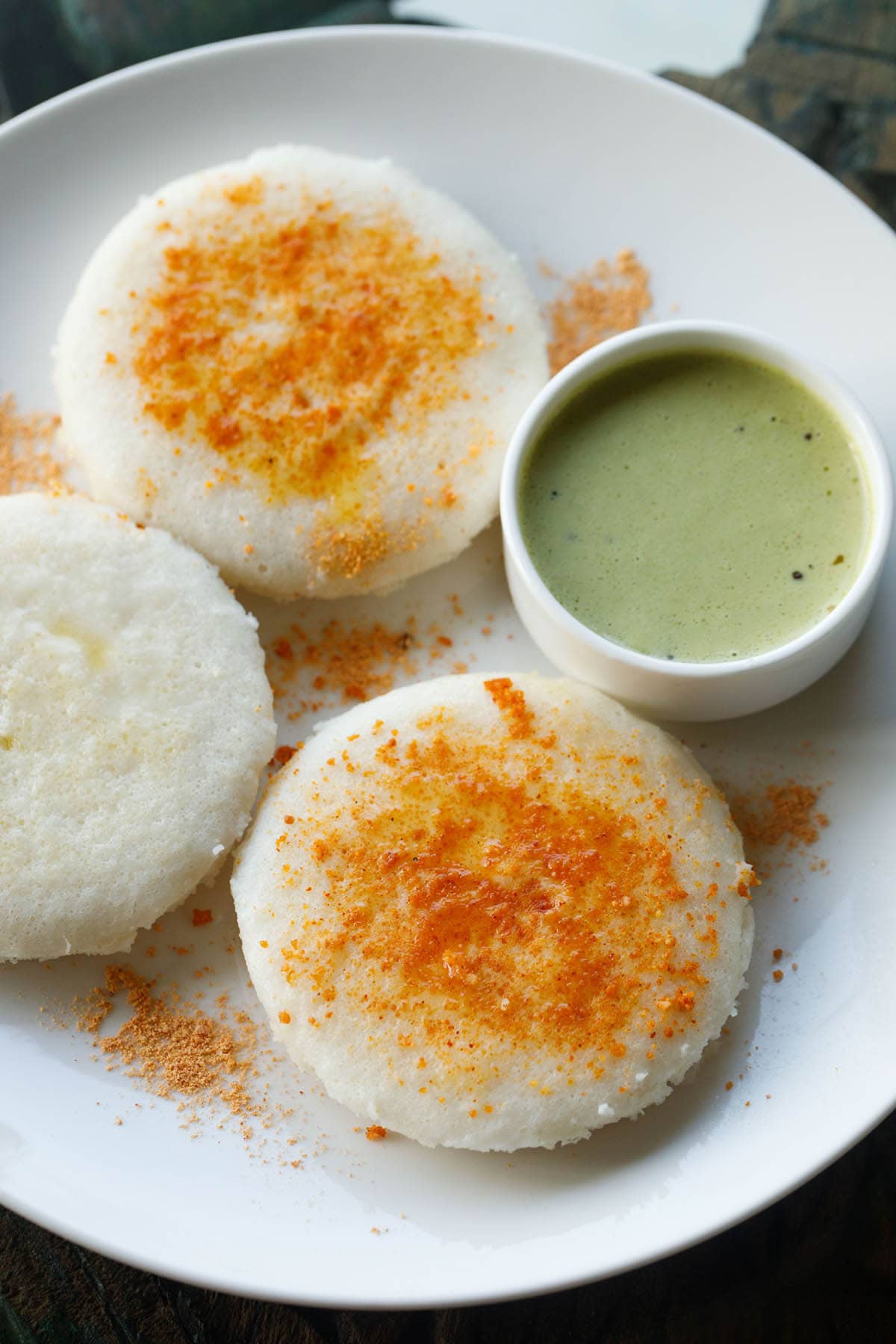
Expert Tips
- Rice Alternatives: If you don’t have idli rice, you can substitute with regular rice like sona masuri, surti kolam or parmal.
- Baking Soda: If the batter hasn’t fermented properly, add around ¼ to ⅓ teaspoon of baking soda to help achieve a soft texture.
- Ingredient Substitutions: You can use puffed rice (murmura) in place of poha, and omit the fenugreek seeds if needed. Sabudana can be left out, but note that the idlis will be a bit less soft without it. All other ingredients are necessary.
- Fermentation: Make sure the batter ferments fully. A well-fermented batter will double or triple in volume, develop a pleasant sour aroma, and show many small air bubbles.
- In Colder Climates: Fermentation may take longer in cold conditions. To speed up the process, keep the batter in a warm spot, such as near a heater or in an oven with the light on.
- Equipment: Traditionally, these idlis are made in specific Thatte Idli plates, which you can find on Amazon. If you don’t have this typical stand, use small rimmed plates, shallow bowls, or a dhokla stand. This batter also works well for making regular idlis, resulting in a soft, spongy texture.
FAQs
It’s called Tatte Idli because it’s steamed in a wide, flat plate, known as ‘tatte or thatte’ in Kannada, giving it a larger and flatter shape than regular idlis.
Plate Idli is larger, flatter, and more fluffier, while regular idlis are smaller, softer, and steamed in round moulds.
Yes, Thatte Idli batter is fermented, which helps create its soft and slightly tangy flavor.
Tatte Idli originated in Karnataka and became popular at roadside eateries, especially along highways, where its larger size made it a filling meal for travelers.
Yes, Plate Idli is nutritious, being a good source of carbohydrates, protein, and fiber from both the rice and lentils, and it’s easily digestible due to fermentation.
More Karnataka Special Breakfasts To Try!
Please be sure to rate the recipe in the recipe card or leave a comment below if you have made it. For more vegetarian inspirations, Sign Up for my emails or follow me on Instagram, Youtube, Facebook, Pinterest or Twitter.

Thatte Idli Recipe | Plate Idli
If there’s an idli variant softer and fluffier than the regular idli, it’s the Karnataka special Thatte Idli or Tatte Idli or Plate Idli. Try this recipe to know. It’s called such as it is steamed in a plate, known as ‘thatte’ in Kannada, giving it a larger and flatter shape than regular idlis.
Prep Time 10 minutes
Cook Time 20 minutes
Soaking Time 5 hours
Total Time 5 hours 30 minutes
To Serve With
Soaking Ingredients & Making Batter
In a bowl take the urad dal fenugreek seeds.
Rinse with water a few times. Soak the urad lentils and fenugreek seeds in water for 5 hours.
In another bowl take idli rice and thick poha (flattened rice).
Rinse again with water for a couple of times and then soak in water for 5 hours.
Similarly take the sabudana (sago) in a small bowl.
Again rinse with water. Soak the sabudana in water for 5 hours.
Before grinding these soaked ingredients, drain all the water from them and set aside.
In a mixer-grinder or a table-top wet grinder, first take the urad dal, fenugreek seeds and sabudana together.
Add 1 cup water and grind to a fine consistency. The batter should not have any granular consistency but should be fine and smooth.
Transfer this batter to a large bowl or pot.
In the same grinder, add a portion of soaked rice and poha. Add some water and grind to a fine grainy consistency.
Same way, grind rice and poha in batches of 1 to 3. You will need to add a total of 1 cup water in portions while grinding in batches.
Remember not to make the rice batter thick or thin.
Pour the rice batter into the same bowl containing the urad dal batter. Add the edible rock salt or according to taste.
- Mix very well. The batter should have a medium-thick flowing consistency. Hence, add the same amount of water as mentioned in the recipe, unless you use a different variety of rice or aged lentils.
Cover bowl/pan with a lid and allow the batter to ferment for 8 to 9 hours or as needed until the batter increases in volume and doubles or triples.
After a good fermentation, the batter will also have a nice fermented sour aroma and plenty of air-pockets.
Making Thatte Idli
Grease oil or ghee lightly on small plates measuring 3 to 6 inches or the special idli plates that you get in the market.
Pour batter covering ¾ of the plate.
Take a large kadai (wok) or a large pan that can accommodate all the 3 or 4 plates.
- You will have to steam 3 to 4 plates at a time using a large pot or pan. If you have the specialized thatte idli plates, then use the stand that comes with these.If you have used the thatte idli stand, steam the idlis in an idli steamer.
In kadai or pan, add 2 to 3 cups depending on its size, depth and volume.
Place a trivet. Let the water begin to gently simmer.
Reduce heat. Gently and carefully place the plates on the trivet.
- Increase the heat to medium or medium-high. Cover kadai or pan with lid and steam for 15 to 20 minutes or as required until the idli are firm to touch. A toothpick or fork inserted should come out clean.
Carefully remove the plates with the help of tongs, as they will still be hot.
Rest for 5 minutes. Gently remove the thatte idli with water moistened spoon or butter knife.
Place the Plate Idlis on a serving plate. Spread some ghee on each plate idli. Sprinkle each plate idli with idli podi and spread it with a spoon.
Serve Thatte Idli hot or warm with coconut chutney. You can also serve with sambar.
- If the batter has not fermented well, consider adding ¼ to ⅓ teaspoon of baking soda.
- Aim for a medium thick batter with flowing consistency. Add water as mentioned in the recipe, while grinding the ingredients.
- If you have used any other variety of rice or aged lentils, you will have to adjust the quantity of water when grinding rice and the lentils.
- Thick batter will yield denser idlis and a thin batter will make them too soft and overly moist that they won’t hold shape.
- If you live in cold places, allow the batter to ferment for some more time.
- You could skip the ghee sprinkling and opt for sesame oil instead. The idli podi can also be given a miss.
Nutrition Facts
Thatte Idli Recipe | Plate Idli
Amount Per Serving
Calories 423 Calories from Fat 72
% Daily Value*
Fat 8g12%
Saturated Fat 1g6%
Polyunsaturated Fat 0.4g
Monounsaturated Fat 6g
Sodium 8mg0%
Potassium 77mg2%
Carbohydrates 80g27%
Fiber 3g13%
Sugar 0.01g0%
Protein 7g14%
Vitamin A 8IU0%
Vitamin B1 (Thiamine) 1mg67%
Vitamin B2 (Riboflavin) 0.1mg6%
Vitamin B3 (Niacin) 4mg20%
Vitamin B6 0.2mg10%
Vitamin B12 0.01µg0%
Vitamin C 0.1mg0%
Vitamin D 0.01µg0%
Vitamin E 3mg20%
Vitamin K 0.4µg0%
Calcium 7mg1%
Vitamin B9 (Folate) 233µg58%
Iron 4mg22%
Magnesium 24mg6%
Phosphorus 96mg10%
Zinc 1mg7%
* Percent Daily Values are based on a 2000 calorie diet.
